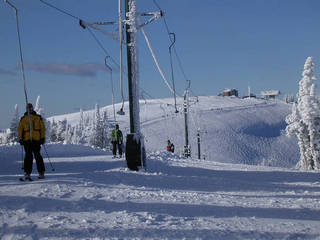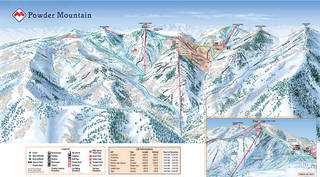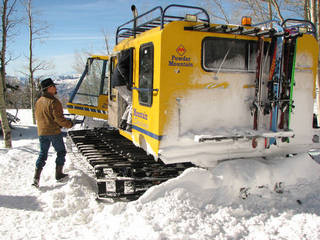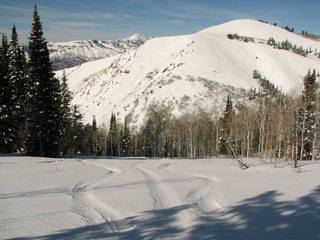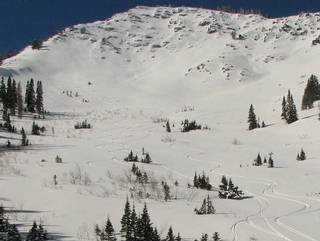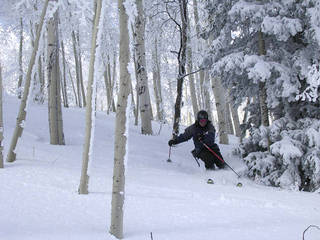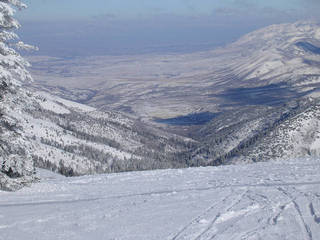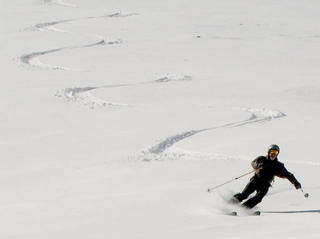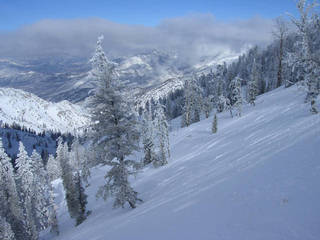Eden, UT – We stopped at the bottom of the bowl to look back up the hill. Four tracks, just four, stretching skyward for over 1,000 vertical feet…and only four of us standing there to witness our handiwork.
That, folks, is the essence of Powder Mountain, a little known deep snow nirvana perched high above Utah’s Ogden Valley. With 5,500 in-bounds acres this little piece of skiing dynamite is bigger than Vail. Bigger, in fact, than any other single ski area in the United States. So why does it fly so far below most skiers’ radar?
|
The Sunrise Poma, Powder Mountain’s definition of a high-speed lift. Click image to open a full-size Powder Mountain trail map in a new browser window. |
There are a multitude of answers to that question. Despite aspirations to transform sleepy Powder Mountain into the next Deer Valley, for now it in essence remains a mom ‘n pop ski area in its purest form. You’ll find only a handful of condos and chalets and a half-dozen hotel rooms in the mountaintop Columbine Inn. Despite acquiring its first high-speed lift last season, uphill transport at Powder Mountain is a quirky mix of fixed-grip doubles, triples and one quad, surface lifts and even school buses. It’s also the farthest major ski area from Salt Lake International Airport which sits a mere 35 minutes from seven major ski resorts situated in the Cottonwood Canyons and surrounding Park City. “Farthest,” however, means a mere 75 minutes, far less time than it takes to drive from Denver International Airport to any major ski area on Colorado’s Front Range. It also lacks the steeps found at its famous neighbors Snowbird and Alta. Many visitors who even make it to nearby Snowbasin, a mere 21 driving miles away, fail to realize that Powder Mountain even exists. The ski area barely advertises beyond the local Ogden market.
Despite these shortcomings Powder Mountain’s stats are hard to ignore. Let’s face it – 5,500 acres is 5,500 acres. Combine that with the small skier population and it takes a long, long time to track out Pow Mow’s 500 average annual inches of snowfall. Vertical drop falls just beyond 2,000 feet. Snowcat skiing is priced at a mere $8 per run, lift tickets are a reasonable $53, and Diamond Peaks helicopter skiing that departs from the mountaintop Hidden Lake Lodge is a relatively inexpensive $150 for 3,000 vertical feet of backcountry skiing bliss. Skiers with a good sense of smell will find virtually every possible compass exposure available at their beck and call.
First Tracks!! Online staff writer Tony Crocker, friend Bob Dangerous, 15 year-old son Michael and yours truly left my Salt Lake City home on stunning mid-February day last winter to drive the 75 minutes north along the Wasatch Front to sample the goods at Powder Mountain. We were heading across Trapper’s Loop Road near Snowbasin when Michael leaned forward from the back seat. “Marc…I forgot my ski boots.”
“Yeah, right,” I replied. “Sure you did.” I’d heard that one before. He started laughing. “Just kidding,” he confirmed.
But at that moment, Tony started looking sheepish. “I forgot mine,” he said quietly. “And I’m not kidding.”
|
Powder Mountain, where snowcat skiing still costs a mere $8 per run. |
The kid’s joke made Tony realize that they were still sitting on the boot dryers downstairs at my house. So after stopping at Valley Market in Eden for a couple of discount lift ticket vouchers, upon arrival at Powder Mountain Tony went in for some rental boots while the rest of us stood in line for lift tickets. I picked up four Lightning Ridge cat skiing vouchers, too, for that wonderful price of $8 each.
This was a holiday weekend, and it became readily apparent that this would be the busiest that I’ve ever seen Powder Mountain. The parking lot was nearly full when we arrived. Ticketing took 15 minutes, yet our only lift line of the day more than 90 seconds was to ride the Sunrise poma, and that was 10 minutes. Slopes were wonderfully devoid of traffic, for it takes an awful lot of people to fill 5,500 acres of terrain.
Tony emerged from the rental shop and realized that he’d left his poles in the truck. It was going be one of those days.
Eventually, somewhere around 9:30 a.m. or so, we headed down the green groomer that led to the Timberline chair. Up Timberline, we headed straight for the new Hidden Lake Express quad to access Powder Country.
Now, allow me to explain Powder Country. Powder Mountain is an upside-down ski area. You approach from the south, park at the top, and the ski lifts all drop down the north side. That leaves hundreds of acres on the south side that lead back down to the access road, and yep, Pow Mow runs an underpowered school bus up and down the steep access road to pick up those who decide to ski the “back side.”
|
Powder Country |
Carving screaming arcs through completely untracked low-angle alpine meadows in Powder Country was one of the highlights of the day. About the only thing that could’ve made it better would have been if the snow was lighter. It fell unusually wet for Utah that week, then the wind whipped it ferociously before it set up in the overnight cold. The result was some incredibly dense stuff, slightly wind crusted, that still skied remarkably well if you carried speed, stayed in the fall line, and sat ever-so-slightly aft of center. And that’s precisely what we did.
We caught the bus back up, and got off at Sunset. Sunset is the first parking lot you come to as you ascend the access road. Standing next to the Sunset base lodge, watching lifties load locals in blue jeans onto the antiquated double chairlift, you could squint your eyes into a sepia tone and envision Utah skiing 50 years ago. It’s Powder Mountain’s night-skiing area and teaching area. It’s also the lift to access the pickup point for the Lightning Ridge snowcats.
|
Lightning Ridge, where the only tracks are our own. |
Again, it was busy, which meant we had a two-cat wait despite the fact that Powder Mountain’s new passenger snowcat carries a whopping 18 passengers. No big deal, for it was warm and sunny outside, and we conversed with others in line and snapped photos while we awaited our turn.
We exited the cat and immediately started up the boot ladder to James Peak. The sun beat down on us, making the climbing more difficult, but I owe a beer to whoever set that immaculate boot ladder. Even though there were only a couple of tracks at that point on the obvious lemming line down James Peak, Bob had other ideas.
We traversed out. And out. And out. Eventually we arrived at his destination, a bowl that…I swear to God…didn’t have a single track in it. None. Nada. An entire bowl to ourselves. It was only at lunch later that I realized that we were actually out of bounds, but there was no rope line to traverse and it was no more difficult to reach and return from than any of the in-bounds lines on Lightning Ridge.
|
Skiing the aspens on Powder Mountain’s Boot Hill. (skier: Roger Klinger) |
That run went on…and on…and on. Not a single track for many vertical feet. Thousands. At the bottom we negotiated an open stream and climbed out no more than 10 vertical feet to board the Paradise lift.
We headed to the Powderkeg Pub via Paradise and Timberline for a quick burger, hot dog and local Ogden microbrew. The Powderkeg is no-frills dining at its finest. Order from the barkeep, who cooks the food as well as pours beer. Floors are unfinished concrete. Furniture is plastic Wal-Mart deck equipment. Somehow, it all fits into the Powder Mountain grand scheme of things.
It was 1:30 pm by the time we got there, and we spent lunch hatching the afternoon plans. Michael headed to the Terrain Park on Sunset, while Bob, Tony and I mulled our options. Another Lightning Ridge run was considered, but Tony, visiting from Los Angeles, wanted to see more of the area, so we went with Tony’s plans.
|
Powder Mountain’s Sunrise Ridge looks out upon stunning views of the Cache Valley below. |
Once again down to Timberline, then some wonderful aspen trees under Hidden Lake Express led us down to that chair, and back up. We followed the road over to the Sunrise Poma, where we had our only true liftline of the holiday weekend Saturday (again, only 10 minutes), and we headed way out into Cobabe Canyon, again scoring untracked through beautifully-spaced low angle trees.
Powder Mountain was developed over the years by hook and by crook. Early staffers would point and say, “Hey, I’ll bet there’s great skiing over there,” and all it took along the summit ridge to reach the next drainage over was a short, simple surface lift to reach the next ridge top and so on, and so on. Cobabe Canyon is one of those “next drainage overs.”
Together with Powder Mountain’s Sunrise Ridge, Cobabe Canyon has to be one of the finest areas anywhere for a low intermediate to learn to ski powder. Slope angles are gentle, the powder prodigious, and traffic remains at a minimum. A mix of open slopes and widely spaced trees, Cobabe Canyon is about as innocuous an initiation to powder as it gets. Experts can scream through the trees, and powder virgins can take the time to get the feel for the experience without feeling threatened.
It was now 3:15, so we headed back up Paradise and Hidden Lake for our planned grand finale. Tony headed back to the rental shop to return his boots. Bob and I went down to Sunset to pick up the kid. Our plans were ready.
|
The author enjoys typical Powder Mountain crowds. (photo: Bob Sederquist) |
Tony was to drive the truck down the access road to the gate just above the Wolf Creek Resort in Eden. We were going to ski down 2,700 vertical feet of the south side of the mountain into the canyon formed by the North Fork of Wolf Creek. This technically starts in the Powder Country area west of the access road, but instead of staying within Powder Country on the east side of the ridge, you drop off the west side of the ridge into the next drainage over.
One more ride up Sunset and we headed out. It was a gorgeous afternoon as the ground fell away below us into the Eden Valley, and in the distance the expanse of the Great Salt Lake was visible in the late day sun through North Ogden Canyon. We had one last 150-vert hike to ascend before clicking back in and heading down into the Wolf Creek drainage.
We gradually worked our way left after each successive untracked powder shot. The skiing on these northwest-facing shots was quite good in spite of the heavy snow that got progressively heavier as we got lower. Eventually at 6,400 feet of elevation we met the 4×4 road that would lead us out.
|
Powder Mountain’s Powder Chamber. |
We had planned to ski out, but the warm weather over the previous week and the day’s brilliant sunshine had other plans. The road winds around folds to follow the contours of the hillside a couple of hundred feet above the creek, and on each successive south-facing hillside the snow cover became less and less until, still three quarters of a mile from the access road where the North Fork and South Fork join, we ran out of snow. No matter, it was a beautiful day for a hike, and Bob and Michael shouldered their skis while I strapped mine to my pack and we hoofed it out the last short distance to Tony waiting in the truck. We arrived at 5 p.m., a wonderful way to cap off a wonderfully typical Powder Mountain day.
The Straight Skinny:
Daytrippers will find Powder Mountain a short 75-minute drive from Salt Lake City. Those who wish to stay overnight will find limited options. The mountaintop Columbine Inn is run by the ski area and offers a handful of rooms for overnight rent. Bring your own food and entertainment (units include kitchens), for after night skiing ends you’ll find absolutely nothing without venturing down the precipitous access road.
If you do wander out, don’t miss the chance to swill suds with the local color at the Shooting Star Saloon in Huntsville. Gawk at the stuffed St. Bernard head on the wall, order a Star Burger, and enjoy the ambience of the last remaining saloon in Utah.
At the bottom of the access road sits the Wolf Creek Resort with a plethora of condo units and its own diminutive ski hill, Wolf Mountain. Aside from a handful of small inns and B&Bs in the Ogden Valley, your only other nearby lodging options consist of the standard chain hotel/motel selection in Ogden proper.
For More Information:
- Powder Mountain Resort: www.powdermountain.com
- Diamond Peaks Helicopter Skiing: www.diamondpeaks.com
- Wolf Creek Resort: www.wolfcreekresort.com
- Ogden Convention & Visitors Bureau: www.ogdencvb.org

